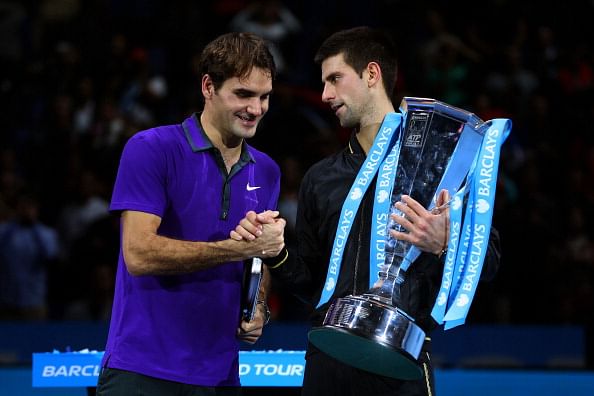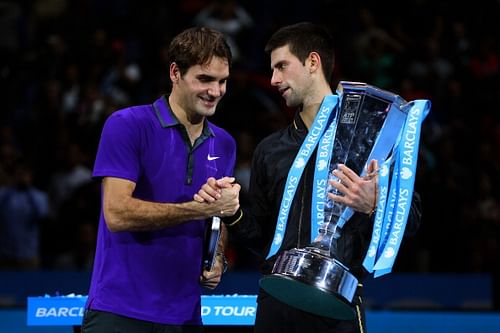
7 things we learned from the 8 days of the World Tour Finals

We were promised a grand finale to the year in London, and we were given one. The World No. 1 defeating the World No. 2 in a thrilling, hard-fought match (yes, sometimes a straight sets victory can be thrilling), in front of thousands of wildly cheering spectators – finales don’t come much grander than that. The tennis season has ended (for the non-Davis Cup-playing population, anyway), and very soon, there will be ‘player of the year’, ‘breakthrough of the year’, ‘comeback of the year’ and many other titles being awarded to the banged-up players in desperate need of a vacation. Before we get to that, though, let’s take a moment to appreciate the spectacular success that the ATP has managed to turn the London year-end champions into, by looking at the seven most important things we learned from this year’s 8-day-long edition:
1. Round robin is here to stay: The round robin format has almost as many advocates as it does critics. The ATP had tried adopting the format at some of its regular tournaments five years ago, but that experiment ended in disaster, to put it mildly. In a tournament that features the 8 best players in the world, though, it’s hard to find too much fault with round robin. The ATP has done a good job of repeatedly spelling out the qualification system in clear terms (side note: wish they had been just as consistent with the name of the tournament). By the middle of the event most followers have the various permutations and combinations rolling off their tongues. The relatively level playing field reduces the chances of there being inconsequential matches (this year there were none; even the Ferrer-Tipsarevic match affected the semifinal match-ups), and adds considerable drama to seemingly innocuous ones (exhibit A: Berdych-Tsonga). So for now at least, it’s thumbs up to round robin.
2. Jo-Wilfried Tsonga needs an attitude makeover: When Roger Rasheed came aboard the Tsonga train as the Frenchman’s coach, he lamented the ‘second-best’ culture that is prevalent among the second tier of men’s tennis (by ‘second tier’ he meant everyone other than the Big 4, of course) today. He also went on to say that his new charge most certainly didn’t have a defer-to-the-big-4 mentality. Is that really so, Mr. Rasheed? Tsonga played three matches in the tournament, and in only one of them did he look like he really believed he could win. And that match was against, surprise surprise, Tomas Berdych – Tsonga’s fellow comrade in the defer-to-the-big-4 camp. Tsonga has the talent, certainly. But will he ever have the mindset that is needed to take the next step?
3. You can’t go wrong with London: Mid-way through the tournament, the ATP officials announced that the World Tour Finals will remain at London till 2015. Why not go a step further and sign a lifetime contract with the O2 arena? Deciding to host the year-end championships at the birthplace of tennis was a masterstroke; by attracting knowledgeable fans but doing away with the prestigious stuffiness of Wimbledon, the tournament has turned into a gleefully self-important, glitzy affair that is hard to turn away from. Everything about the event spells drama – from the spotlight-style bulbs flashing on the court to the theatrical banners of ‘SET POINT’ circulating around the stadium, the tournament feels almost as much like a show as the US Open. And that’s a good thing whichever way you look at it.
4. The tank is getting ready to rumble: Juan Martin Del Potro has been knocking on the doors of tennis’s elite club for about two whole years now, but his knocks have largely been greeted with disappointment and despair. His wrist injury took more from him than we thought, and he had even started looking like a one-Slam wonder for a while there. Not anymore. The Argentine followed up his shackle-breaking win over Roger Federer at Basel with another win over the Swiss here, and gave Djokovic a run for his money in the semis before cooling off just enough to allow the World No. 1 back into the match. The big serve and monster forehand are firing again, the consistency is close to where it was in 2009, and the hunger is back too. It might not be long before the Big 4 turns into the Big 5.
5. Turbo-charged defense is the new mantra (if we didn’t know that already): After losing the final in the face of some supernatural defense from Djokovic, Federer suggested that it might be a good idea to speed up the courts so that attacking play earns better rewards. Djokovic himself admitted that he had consciously employed a defensive strategy in the final. “I managed to get a lot of shots back into the court, being passive, a couple meters behind the baseline”, Djokovic said. “That was one of the goals tonight, to always try to get him into the longer rallies where I think I had the better chance”, he went on. Federer’s suggestion has some merit: he isn’t advocating that all the courts be quickened, but instead wants certain tournaments to have faster courts so that players don’t have to “hit 15 great shots and at the end, end up with an error”. Federer believes that by lowering the premium on defense, the playing field could be leveled which, in turn, would loosen the monopoly of the Big 4 on the big tournaments. All of this sounds nice in theory, but have the existing quick courts given any indication that attacking play can come back in vogue? The courts in London, by Federer’s own admission, are fairly quick, and Djokovic still managed to frustrate the living daylights out of the Swiss by repeatedly getting the ball back in play. The top players today are quicker, fitter and more consistent with defense, and no amount of surface-quickening is going to help an attacking player hit through the modern-day baseliner with any kind of regularity.
6. The aging process is well and truly underway: Yes, Federer has proven the doubters wrong way too many times in the past. No, that is not a reason we should ignore all the tell-tale signs. Federer did win Wimbledon and get back the No. 1 ranking just four months ago, but it’s becoming increasingly clear that sustained strong play is a thing of the past for him. He can still produce those moments of magic (his backhand half-volley winner from the baseline against Murray was particularly goosebump-inducing), but he can just as easily lose his focus the very next point and make a ghastly error. In the first set tiebreak against Djokovic, for instance, he saved a set point at 5-6 with a highlight-reel forehand winner, and followed that with an inexplicable backhand error to hand the Serb a set point on serve (which was duly converted, of course). He almost invariably struggles against the power hitters now, and his movement towards his forehand side has started looking sluggish and ungainly. As much as we’d like to believe that this is earth-shattering news, though, it isn’t. The decline had to start at some point. If it didn’t, we might have had to start speculating whether the man is even human.
7. Novak Djokovic has turned into the Serena Williams of the ATP: Seriously, how many comeback wins can one man produce in a single season? It’s come to a point that we almost expect Djokovic to go down set point or match point before the match really starts heating up. He came back from a set down against Andy Murray, saved three set points against Berdych, came back from a set and a break down against Del Potro and saved two set points against Federer (the last of which came in vintage 2011-US Open style to boot). If Tsonga lacks the belief that he can defeat the top players, Djokovic seems to lack the belief that he can lose to the top guys. Maybe the rest of the men’s field should devise a way to defeat Djokovic without getting to match point?